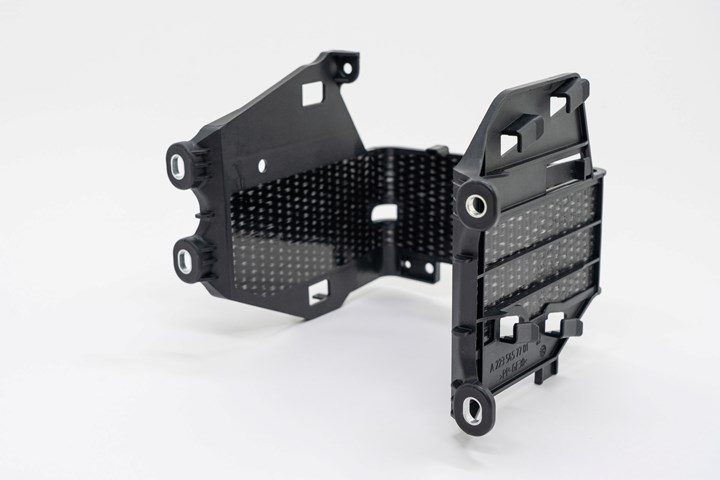Lanxess demonstrates Tepex composite material in structural bracket application
Lightweight bracket offers firm clamping of batteries in Mercedes-Benz S-Class with high strength under sustained dynamic stress, functional integration and no risk of short circuiting.

Photo Credit: Lanxess
Lanxess (Cologne, Germany) continues to identify successful applications for its Tepex continuous fiber-reinforced thermoplastic composite material, from an automotive load compartment well to the more recent production of structural bracket components to hold the battery that supplies electricity to the automated driver assistance system “Intelligent Drive” in the Mercedes-Benz S-Class in the event of sudden power failure.
The bow-shaped bracket is made by Poeppelmann Kunststoff-Technik GmbH & Co. KG (Lohne, Germany) using Lanxess’ polypropylene-based Tepex dynalite 104-RGUD600(4)/47%. The manufacturing method is a two-stage process combining forming (draping) of the composite with injection molding.
“The composite design means that the finished product can be as much as 40% lighter than a version made from metal,” says Joachim Schrapp, an expert in lightweight design at Poeppelmann. “The injection molding step also enables functions to be integrated that not only make it much easier to install the bracket but also cut down on the logistical workload. All this has a beneficial effect on manufacturing costs.”
The bracket’s job, Lanxess says, is to hold the ~10-kilogram battery firmly in place in the rear compartment of the vehicle by clamping alone, even when subjected to the considerable acceleration forces that occur in a collision. The bracket is designed to ensure that most of the forces are transferred from the points of application via the continuous glass fibers of the composite material. Further, because the Tepex blank does not creep under highly sustained stresses, deformation does not occur, and a high degree of fatigue strength ensures the material doesn’t become brittle or crack over time due to frequent, heavy vibration.
According to Lanxess, Tepex’s corrosion resistance and electrical characteristics also benefits this application. The former reportedly makes transportation and storage easier than would be the case for metal coils. The latter, Schrapp says, ensures that it is “electrically insulating to the body and the metal components of the battery, which significantly reduces the risk of short circuits. A component made from metal, however, would require additional measures to protect against short circuits.”
For this applicaiton, Tepex’s polypropylene matrix is reinforced with four layers of continuous glass fiber, most of them arranged in one direction. The injection-molded compound, which is reinforced with short glass fibers, is also polypropylene-based, creating a strong bond between the two. Integration of guides for cables, as well as mounts and fasteners into the bracket for two control units occurs during the injection molding stage, so that the equipment can be clipped rather than scewed into place during installation.
Related Content
-
Real-time assessment of thermoset composites curing
The combination of material state management (MSM) software and an encapsulated sample rheometer (ESR) enables real-time cure recipe management or cure model development inside the autoclave.
-
Aviation-specific battery system uses advanced composites to address electric, hybrid flight
BOLDair’s composite enclosure, compression structures and thermal runaway management enables high-performance electric energy storage.
-
Al Seer Marine, Abu Dhabi Maritime unveil world’s largest 3D-printed boat
Holding the new Guinness World Record at 11.98 meters, the 3D-printed composite water taxi used a CEAD Flexbot to print two hulls in less than 12 days.
















